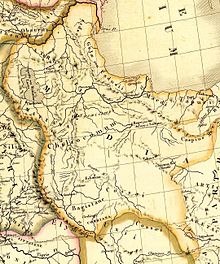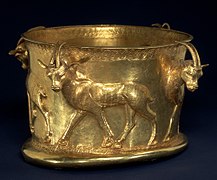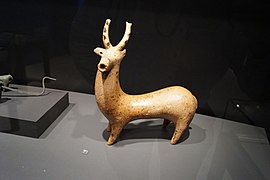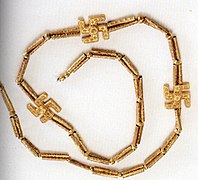Amardi
| Part ofa serieson the History of Tabaristan |
|---|
 |
|
|

TheAmardians,widely referred to as theAmardi(and sometimesMardi), were an ancientIranian[1]tribe living along the mountainous region bordering theCaspian Seato the north,[2]to whom theIron Ageculture atMarlikis attributed.[3]They are said to be related to, or the same tribe as, theDahaeandSacae.That is to say, they wereScythian.[4]Herodotusmentions a tribe with a similar name as one of the ten to fifteenPersiantribes inPersis.[1][5]
They lived in the valleys in between theSusisand Persis,[6]in what is now southwestern Iran. The southern Mardi are described byNearchusas one of the four predatory mountain peoples of the southwest, along with the Susians,Uxii,andElymaeans.[7]Of these four nomadic groups, they were the only tribelinguisticallyIranian.[8]
Etymology[edit]
The termMardicomes from theOld Iranianword for "man"[6](Old Persian:𐎶𐎼𐎫𐎡𐎹martiya;fromProto-Indo-European*mr̥tós,"mortal" ).
Richard N. Fryebelieve that the name of the city ofAmolis rooted in the wordAmard,which occurs asAmuiinMiddle Persian.[9]According to historical literature, Amol was the capital ofTapuria(modern-dayMazanderan), at least in the period starting from theSasanian Empireto theIlkhanateof theMongol Empire.
Historical accounts[edit]
Strabomentions the nameMardiseveral times. He places their location to the south of the Caspian Sea in what is nowGilanandMazanderan,in northernIran.[3][7]On his map, he mentionsAmardos(and theAmardosriver), the name attributed to the region ofSefidrudat the time.[3][10]
Herodotusmentions a tribe with a similar name as one of the ten to fifteenPersiantribes inPersis.[1][5]They lived in the valleys in between theSusisand Persis,[11]in what in now southwestern Iran. The southern Mardi are described byNearchusas one of the four predatory mountain peoples of the southwest, along with the Susians,Uxii,andElymaeans.[7]Of these four nomadic groups, they were the only tribelinguisticallyIranian.[12]
Gallery[edit]
-
Map of theMedian Empire(600 BC), showing the relative locations of the Amardian tribe.
-
The Hyrcanian Golden cup. Dated first half of first millennium. Excavated atKelardasht,Mazandaran.
-
Deer stagMarlik
See also[edit]
Further reading[edit]
- "The Mardians: A Note"(PDF).Leonardo Gregoratti (Durham University,UK).Anabasis, Studies for Classical Eastern Orientalism.
References[edit]
- ^abc"IRAN"[v. PEOPLES OF IRAN (2) Pre-Islamic].Encyclopædia Iranica.Vol. XIII.RetrievedJuly 20,2017.
- ^Compact Bible atlas with gazetteer.Baker Book House. 1979. p. 7.ISBN9780801024320– via Google Books.
-Smith, William (1854).Dictionary of Greek and Roman Geography.Vol. 1. Little, Brown & Company – via Google Books.
-Indo-iranica.Vol. 2. Iran Society. 1947. p. 21 – via Google Books. - ^abcNegahban, Ezat O. (1995).Marlik: The Complete Excavation Report.UPenn Museum of Archaeology. p. 321.ISBN9780924171321.
- ^Norris, Edwin (1853).Memoir on the Scythic Version of the Behistun Inscription.Harrison and Sons.
- ^abEncyclopaedia Iranica.Vol. 13.Routledge& Kegan Paul. 2004. p. 336.ISBN9780933273955.RetrievedMay 21,2020.
- ^abEadie, John (1852).Early Oriental History, Comprising the Histories of Egypt, Assyria, Persia, Lydia, Phrygia, and Phoenicia.Griffin.ISBN9780848207410.
- ^abc"CASPIANS".Encyclopædia Iranica.Vol. V. p. 62.RetrievedJuly 20,2017.
- ^electricpulp."IRAN v. PEOPLES OF IRAN (2) Pre-Islamic – Encyclopaedia Iranica".iranicaonline.org.Retrieved2017-08-07.
- ^Richard N. Frye. "Ancient Central Asian History Notes".Proceedings of the Second European Congress of Iranian Studies.Rome: ISMEO. p. 188.
town of Amul on the Amu Darya and the Amul in Mazanderan, Iran, both of which may be traced back to the migration of an Iranian tribe called Amardi or Mardi
- ^"GĪLĀN"[iv. History in the Early Islamic Period].Encyclopædia Iranica.Vol. X. pp. 634–635.RetrievedJuly 20,2017.
-Wright, John Henry (1905).A history of all nations from the earliest times.Lea Brothers. - ^Eadie, John (1852).Early Oriental History, Comprising the Histories of Egypt, Assyria, Persia, Lydia, Phrygia, and Phoenicia.Griffin. p.276.
mardi.
- ^electricpulp."IRAN v. PEOPLES OF IRAN (2) Pre-Islamic – Encyclopaedia Iranica".iranicaonline.org.Retrieved2017-08-07.





